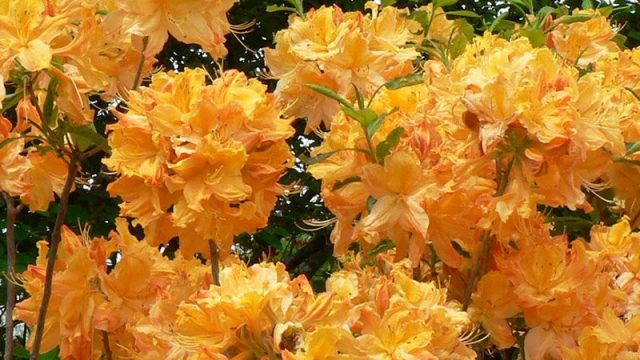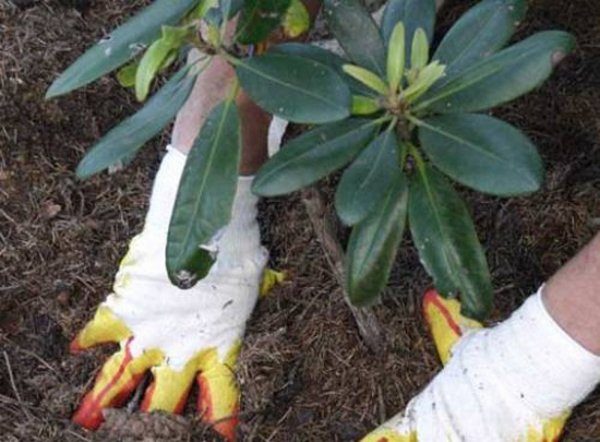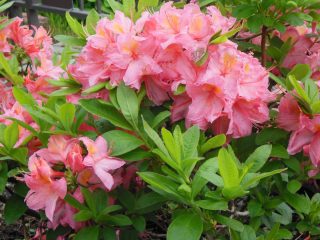Content
Rhododendron Golden Lights is a hybrid of deciduous ornamental shrubs, the first varieties of which were bred by American breeders in the late 70s. last century as part of the work on creating a variety of frost-resistant rhododendrons. This shrub is popular among domestic gardeners and is widely used in landscape design projects.
Description of Rhododendron Golden Lights
Rhododendron or azalea Golden Lights (Rhododendron Golden Lights) is a slowly growing ornamental bush, reaching a height of 150–200 cm by the age of 10. The crown width is from 100 to 150 cm. The plant is compact and has a straight shape. The shoots are densely branched; with age, the crown thickens and forms a hemispherical shape.
The leaf blade of rhododendron or azalea is wide, oblong, pointed at the ends, wedge-shaped at the base. The leaves are green-olive in color, in the fall - rich, bright burgundy. In winter the leaves fall.
Rhododendron or Golden Lights azalea is an early variety.It is noteworthy that the hybrid enters the flowering phase simultaneously with the appearance of leaves - in mid-May. Blooms profusely with funnel-shaped flowers up to 5–6 cm in diameter with a pronounced sweet aroma. The flowers are pink-orange, having a lighter shade towards the edges of the petals. Collected in inflorescences consisting of 10 flowers. Flowering lasts a little less than a month, but throughout the season the bush does not lose its attractiveness thanks to its beautiful crown.
Frost resistance of rhododendron Golden Lights
Rhododendron or Golden Lights azalea is an extremely frost-resistant hybrid that can withstand temperatures down to -37°C. In the conditions of the Russian winter, he feels comfortable without shelter for the winter, not only in the middle zone, but also in regions with a more severe climate.
Planting and caring for deciduous rhododendron Golden Lights
In the minds of many amateur gardeners, rhododendron or azalea is a capricious crop that requires special care and a lot of experience, but the deciduous variety Golden Lights is less whimsical than its evergreen relatives.
Selection and preparation of a landing site
To plant this shrub, you should choose a place protected from strong winds and direct sun. Azalea Golden Lights will feel comfortable in the shade of trees or buildings. With this placement, it is worth taking into account the likelihood of snow falling from the roofs, so the distance from the wall to the bushes should be at least 3 m. It is best to place this moisture-loving crop near ponds or fountains.
For planting the Golden Lights hybrid, light, slightly acidic and acidic soils, moist but well-drained, are suitable; On heavy clay soils and in places with stagnant moisture, rhododendron grows extremely poorly.
Seedling preparation
Obtaining rhododendron or Golden Lights azalea seedlings from cuttings requires the following steps:
- during the spring formation of buds in an adult plant, shoots up to 10 cm long are cut off, leaving an oblique cut;
- the bark at the base of the shoot is carefully peeled off;
- cuttings are soaked in a root growth stimulator for 24 hours;
- prepare a substrate for rooting: 3 parts sawdust to 1 part sand;
- The cuttings are rooted in the substrate at an angle of 30°, watered, placed under film or glass, ensuring the soil temperature is +24°... +26°C.
Landing rules
Rhododendron Golden Lights tolerates planting well, but if the technology is disrupted, it will not grow for a long time and may even die. It is recommended to adhere to the following landing algorithm:
- dig planting holes with dimensions of approximately 60x60x60 cm;
- pour drainage in a layer of 10 - 15 cm;
- fill the hole halfway with sphagnum;
- pour a mixture of soil and leaf humus on top;
- place the bush vertically, straighten the root system;
- cover with soil without deepening the root collar;
- water (you can add a growth stimulator to the water);
- mulch.
Watering and fertilizing
Azalea Golden Lights does not tolerate drought well, but moisture stagnation should not be allowed. During the season, the shrub is watered once every 3-4 days. If possible, it is better to use water acidified with organic acids. There should be 1-2 buckets of water per tree. On the hottest and driest days, the crown is additionally sprayed. Abundant watering is especially important when the bush is flowering. In winter, 1 watering per week is enough and only in dry weather.
For Golden Lights azaleas, they use fertilizer for heather crops that acidifies the soil. Before the onset of frost, potassium and phosphorus fertilizers are applied. In early spring, before the buds swell and buds form, plants are fertilized at the rate of 2 tbsp. l. mineral fertilizers per 1 sq. m. soil. It is not recommended to fertilize during the formation of buds.
Trimming
Rhododendron or azalea tolerates pruning well. Young bushes up to 4 years of age are regularly pruned, thereby forming a bush. In adult specimens, shoots that are too long are shortened by half and the inflorescences remaining after flowering are removed.
Preparing for winter
Rhododendron or Golden Lights azalea winters well in Russia without shelter. Young plants need protection from frost for the first 2 years after planting; adult shrubs also require shelter if the winter has little snow. Most often, spruce branches or burlap are used for this purpose. In order for the shrub to overwinter well, it is watered abundantly before the onset of frost. It is recommended to mulch the plantings for the winter.
Reproduction
Rhododendron or Golden Lights azalea is most often propagated vegetatively, that is, by layering and cuttings. You can also get plants from seeds, but this is a much longer and more troublesome path. Seeds are germinated in early spring in boxes under special temperature conditions. Azaleas obtained in this way bloom no earlier than 5 years of age, whereas when propagated by cuttings and layering, a young bush can bloom as early as the next year.
The most common method of propagating azaleas is by rooting cuttings. In early spring, last year's shoots are tied with wire, bent to the soil, secured and sprinkled with substrate. Layers must be watered regularly. In the fall of next year, the rooted plants can be separated from the parent bush.
Diseases and pests
A varietal feature of Golden Lights azalea is its resistance to fungal diseases. However, the crop can be affected by spider mites, mealybugs, and rhododendron bugs. These pests can be gotten rid of using any insecticide.
Conclusion
Rhododendron Golden Lights is one of the most unpretentious and hardy flowering shrubs. Exceptional frost resistance and immunity to diseases, combined with the magnificent appearance of the flowering plant, make it attractive for use in landscape design by professional gardeners and amateurs.











